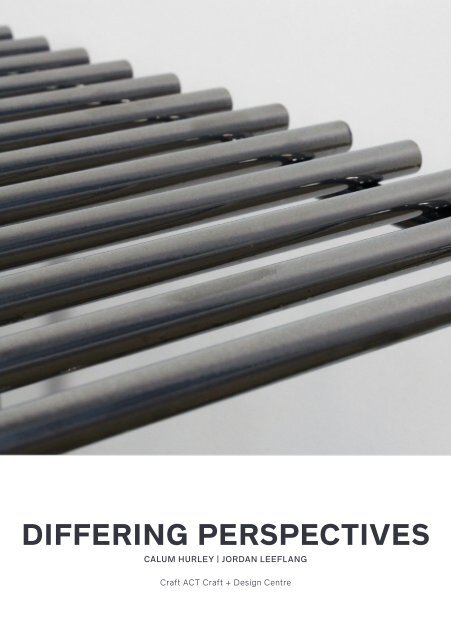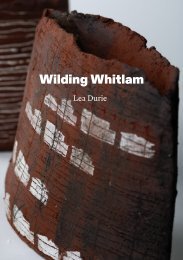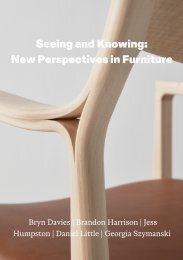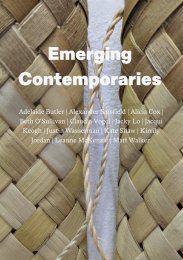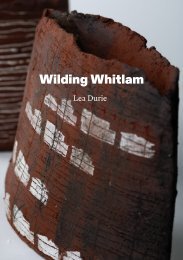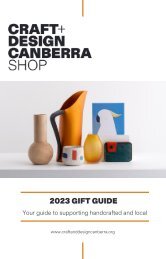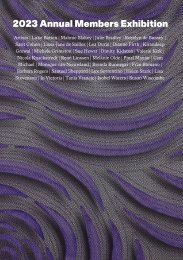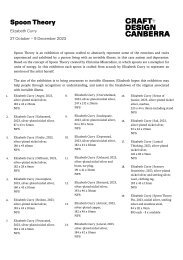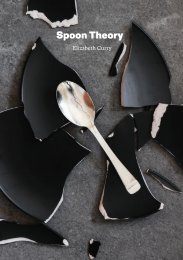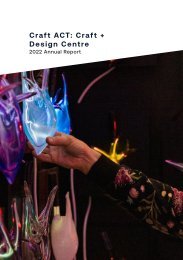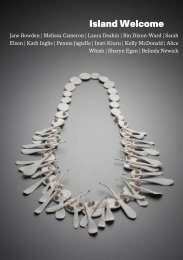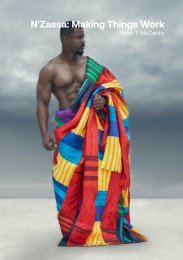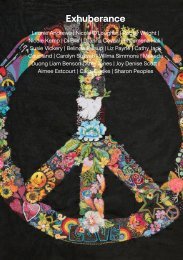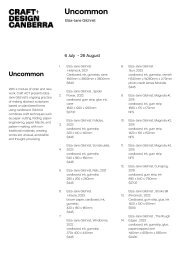Differing Perspectives
Differing Perspectives 2 July - 22 August 2020 Calum Hurley | Jordan Leeflang Responding to photographs of metropolitan Japan, Calum Hurley and Jordan Leeflang have created sculptural objects and pieces of furniture inspired by six different photographs. Each image - captured by Hurley in 2017 - was chosen to show the country’s unique architectural forms and urban landscape. The images display a strong representation of national design identity that both artists have experienced at different stages of their lives. With differing design outcomes emerging from a singular source, audiences are invited to trace the stylistic patterns and individual touches that emerge from each artist. The presentation of the original source image along with the resulting forms prompts viewers to engage with the work personally and conceptualise their own interpretations. Coming from similar educational and training backgrounds in the fields of Interior Architecture & Furniture Design; Hurley and Leeflang were curious about exploring the differences that emerge in their ways of thinking and problem-solving. Their design processes naturally focus on function and human interaction. Hurley’s practice gravitates towards reflectivity and light play. Leeflang’s focuses on proportion, colour and shape. The concept of this collaborative show aims to extend the artist’s creative capabilities by pushing them to question their processes, artistic practices, and aesthetic tendencies. Differing Perspectives was an opportunity for the artists to design without the constraints of market viability and social expectation and showcase the more experimental elements of their practices.
Differing Perspectives
2 July - 22 August 2020
Calum Hurley | Jordan Leeflang
Responding to photographs of metropolitan Japan, Calum Hurley and Jordan Leeflang have created sculptural objects and pieces of furniture inspired by six different photographs. Each image - captured by Hurley in 2017 - was chosen to show the country’s unique architectural forms and urban landscape. The images display a strong representation of national design identity that both artists have experienced at different stages of their lives. With differing design outcomes emerging from a singular source, audiences are invited to trace the stylistic patterns and individual touches that emerge from each artist. The presentation of the original source image along with the resulting forms prompts viewers to engage with the work personally and conceptualise their own interpretations.
Coming from similar educational and training backgrounds in the fields of Interior Architecture & Furniture Design; Hurley and Leeflang were curious about exploring the differences that emerge in their ways of thinking and problem-solving. Their design processes naturally focus on function and human interaction.
Hurley’s practice gravitates towards reflectivity and light play. Leeflang’s focuses on proportion, colour and shape. The concept of this collaborative show aims to extend the artist’s creative capabilities by pushing them to question their processes, artistic practices, and aesthetic tendencies. Differing Perspectives was an opportunity for the artists to design without the constraints of market viability and social expectation and showcase the more experimental elements of their practices.
Create successful ePaper yourself
Turn your PDF publications into a flip-book with our unique Google optimized e-Paper software.
DIFFERING PERSPECTIVES<br />
CALUM HURLEY | JORDAN LEEFLANG<br />
Craft ACT Craft + Design Centre
Craft ACT: Craft + Design Centre is supported by the ACT<br />
Government, the Visual Arts and Craft Strategy – an initiative<br />
of the Australian State and Territory Governments, and the<br />
Australia Council for the Arts – the Australian Government’s arts<br />
funding and advisory body.<br />
CRAFT ACT CRAFT + DESIGN CENTRE<br />
Tues–Fri 10am–5pm<br />
Saturdays 12–4pm<br />
Level 1, North Building, 180 London Circuit,<br />
Canberra ACT Australia<br />
+61 2 6262 9333<br />
www.craftact.org.au<br />
Cover: #9 Hush Side Table, 2020 (detail)<br />
Photo: courtesy of the artist<br />
Next: Previous: Key Inspiration Photograph #1<br />
Photo: Calum Hurley
DIFFERING PERSPECTIVES<br />
CALUM HURLEY | JORDAN LEEFLANG<br />
Craft ACT Craft + Design Centre<br />
2 JULY - 22 AUGUST 2020<br />
3
4
5
6
7
<strong>Differing</strong> <strong>Perspectives</strong><br />
Exhibition statement<br />
Responding to photographs of<br />
metropolitan Japan, Calum Hurley and<br />
Jordan Leeflang have created sculptural<br />
objects and pieces of furniture inspired<br />
by six different photographs. Each image<br />
- captured by Hurley in 2017 - was chosen<br />
to show the country’s unique architectural<br />
forms and urban landscape. The images<br />
display a strong representation of national<br />
design identity that both artists have<br />
experienced at different stages of their<br />
lives. With differing design outcomes<br />
emerging from a singular source,<br />
audiences are invited to trace the stylistic<br />
patterns and individual touches that<br />
emerge from each artist. The presentation<br />
of the original source image along with<br />
the resulting forms shall prompt viewers<br />
to personally engage with the work and<br />
conceptualise their own interpretations.<br />
Hurley’s practice gravitates towards<br />
reflectivity and light play. Leeflang’s<br />
focuses on proportion, colour and shape.<br />
The concept of this collaborative show<br />
aims to extend the artist’s creative<br />
capabilities by pushing them to question<br />
their processes, artistic practices,<br />
and aesthetic tendencies. This was<br />
an opportunity to design without the<br />
constraints of market viability and social<br />
expectation, and showcase the more<br />
experimental elements of their practices.<br />
Coming from similar educational and<br />
training backgrounds in the fields of<br />
Interior Architecture & Furniture Design;<br />
Hurley and Leeflang were curious about<br />
exploring the differences that emerge in<br />
their ways of thinking and problem solving.<br />
Their design processes naturally focus on<br />
function and human interaction.<br />
Previous: Jordan Leeflang, #1 Cab Chair, 2020<br />
Black wood, felt upholstery<br />
Photo: courtesy of the artist<br />
Opposite: Calum Hurley, #1 Bench/es, 2020<br />
Powder-coated steel, American White Ash<br />
Photo: courtesy of the artist<br />
9
Exhibition essay<br />
Catalogue essay: Guy Keulemans + Kyoko Hashimoto<br />
By the time we were invited to write<br />
this essay for Calum Hurley and Jordan<br />
Leeflang’s exhibition at Craft ACT, the<br />
impact of COVID-19 on the world was<br />
emerging. What has eventuated – the<br />
closing of borders, supply chains paranoia<br />
and a surge in nationalistic, often<br />
hostile rhetoric between East and West<br />
– clouds the kinds of cultural engagement<br />
that is at the heart of this timely<br />
exhibition. Its incarnation hinges on a series<br />
of photographs taken in 2017 during<br />
a trip to Japan, a physical, real-world encounter<br />
with a material culture. If COVID<br />
came 3 years early, this exhibition would<br />
not have been possible.<br />
Or would it?<br />
Hurley’s images show an interest in<br />
streetscapes and buildings that would<br />
be typically ignored by local Japanese,<br />
but to Hurley’s foreign eyes are full of<br />
unusual or unexpected design choices,<br />
styling and visual expressions. Perhaps<br />
driven by the knowledge that Japan’s<br />
more famous architecture and historical<br />
icons are well photographed already,<br />
Hurley points his lens at the everyday.<br />
But this choice is not the heart of the<br />
project. Similar photographs are now<br />
uploaded, in the millions and billions, to<br />
the archives of Google Street view, Flickr<br />
and numerous other internet databases.<br />
Digital street views are approaching a<br />
seamless virtual experience. The world<br />
is being mapped in 2D, and in 3D as well.<br />
Photogrammetry, that World War Two<br />
modelling technology developed so nations<br />
could bomb each other, now allows<br />
architects and archaeologists to work<br />
remotely. None of this entirely replaces<br />
the experience of the real, but it can simulate<br />
it sufficiently, depending on expectations.<br />
We argued this point amongst<br />
ourselves: could Hurley and Leeflang<br />
reproduce their work by trawling through<br />
the online trove of algorithmically sorted<br />
images of Japan? Could they replace<br />
the affective experience of a subject<br />
afforded by their framing of the lens?<br />
Would they grok a cultural impression<br />
of Japan without the things that escape<br />
digital capture – smells, touches, emotions?<br />
The reality is that if they wanted<br />
10
to continue the project today, at the time<br />
of writing, on May 26th 2020 in the time<br />
of COVID, they would have to try.<br />
This hypothetical challenge is worth<br />
reflection because it leads to something<br />
more important, something that we think<br />
is the heart of this exhibition: the translation<br />
of information from one culture<br />
and from one medium into another. This<br />
is the transmutation of many distinct,<br />
idiosyncratic, but mostly hidden design<br />
choices from Japanese architecture and<br />
urban design into Australian furniture<br />
and homewares. At a time when nations<br />
are locking up borders, airlines are going<br />
bankrupt and international tourism barely<br />
exists, it is more important than ever<br />
to understand foreign cultures and work<br />
towards global empathy, lest we regress<br />
back to the xenophobia and intolerances<br />
of past decades. The subtlety of Hurley<br />
and Leeflang’s contribution, through<br />
the medium of design, is an affective<br />
contribution, priming the senses for the<br />
new and unexpected in the aesthetic<br />
dimension. The engagement with foreign<br />
culture through design may not be as<br />
overt as an overseas trip, but it’s a special<br />
component of the interlocking and<br />
interweaving mix of global society. Even<br />
if the threat of COVID wanes, as we all<br />
hope, we should nonetheless forestall a<br />
post-COVID surge in international travel.<br />
For the sake of the planet, we must consider<br />
the heavy and potentially irreversible<br />
impact of air transport, freight and<br />
cargo emissions on climate change.<br />
Our position on this points to the success<br />
of Hurley and Leeflang in their future<br />
as professional Australian furniture<br />
designers. Currently, our local makers<br />
barely compete with foreign imports.<br />
Survival shouldn’t be so precarious. We<br />
propose that cultural exchange and global<br />
understanding is not dependent on<br />
physical travel, but neither should it be<br />
dependent on the international shipping<br />
of goods. Vis a vis, lets invest, and take<br />
pleasure, in a resurgence of local design<br />
and craft. As Hurley and Leeflang prove<br />
in their sensitive works, it is an industry<br />
that creates objects that capture the<br />
virtual, but which themselves cannot<br />
be virtualised: behold, the locally made<br />
chair, mirror and table!<br />
Guy Keulemans + Kyoko Hashimoto<br />
Designers, artists and researchers<br />
Next: Screenshot of Tochomae Station in Tokyo<br />
on Google Maps
12
13
Calum Hurley<br />
Artist statement<br />
Having grown up between Australia,<br />
Scotland, Ireland, then Australia again,<br />
I have a keen awareness that objects<br />
and furniture must intrinsically include<br />
opportunity for disassembly, to be<br />
multi-functional or space sensitive, or<br />
be small or robust enough that you can<br />
take them with you. Currently working<br />
out of JamFactory’s Furniture Studio,<br />
I produce objects for the home as well<br />
as a range of exhibition works. With an<br />
engrained interest in reflection, light play,<br />
and the illusion of space, much of my work<br />
involves reflective elements in one form or<br />
another.<br />
Biography<br />
Calum Hurley is an Adelaide based<br />
furniture and object designer. Currently<br />
working out of JamFactory’s Furniture<br />
Studio as part of the esteemed Associate<br />
Training Program, Hurley produces<br />
objects that are consciously spacesensitive<br />
and visually distinct. He has been<br />
a finalist in several high caliber emerging<br />
design competitions across Australia<br />
including Denfair’s FRONT | CENTRE and<br />
WORKSHOPPED19 at Australian Design<br />
Centre.<br />
My workspace is currently stacked with all<br />
things Jesmonite. I am looking to refine<br />
my casting and moulding techniques<br />
whilst gaining a broader understanding<br />
of this adaptive materials potential<br />
applications.<br />
Previous: Key Inspiration Photograph #9<br />
Photo: Calum Hurley<br />
Calum Hurley, #9 Shrine005, 2020<br />
Jesmonite, cast. Photo: courtesy of the artist
Jordan Leeflang<br />
Artist statement<br />
I make furniture and objects featuring<br />
repetitive elements. I’m drawn to this<br />
repetition, perhaps from my studies in<br />
interior architecture, it’s both the visual<br />
result and the process required to achieve<br />
it that hook me. The repetitive elements<br />
are often the details, rather than the whole<br />
form. En masse, a sharp angle softens,<br />
and the visual tension that this creates is<br />
fascinating to me. I want people to look<br />
closer, I want to invite curiosity, I believe<br />
objects should have that power to draw<br />
people in.<br />
In my predominant medium of timber,<br />
I use jigs and templates to create<br />
repeatable elements. These smaller<br />
objects form patterns through angles,<br />
folds and joins.<br />
Biography<br />
Jordan Leeflang is an Adelaide based<br />
designer whose multidisciplinary practice<br />
includes furniture, object and sculpture.<br />
While studying a Bachelor of Interior<br />
Architecture at the University of South<br />
Australia, Jordan took a furniture design<br />
studio and found his niche. Following<br />
graduation in 2016, he went on to<br />
study Furniture Making at TafeSA, and<br />
experimenting in his shed until being<br />
accepted into the Associate Program at<br />
JamFactory’s Furniture Studio in 2019.<br />
Jordan has been involved in a number of<br />
design competitions, winning the 2019<br />
Workshopped Award for Design for his<br />
Sunday Stool, and gaining an honourable<br />
mention in the VIVID object category in<br />
the same year for his Soft Spot Bowls. His<br />
work has been exhibited in Adelaide Fringe<br />
and Melbourne Design Week in 2020.<br />
Jordan Leeflang, #9 Hush Side Table + Ceramic<br />
Vessel, 2020, Powder-coated steel, fabricated by<br />
Tom Golin. Hand-built ceramic vessel by Hannah<br />
Vorrath-Pajak. Photo: courtesy of the artist<br />
Next: Key Inspiration Photograph #3<br />
Photo: Calum Hurley<br />
Page 22-33: Calum Hurley, #3 Chair001 (Grey),<br />
2020. Powder-coated steel, Jesmonite, Handspun<br />
woolen upholstery. Photo: courtesy of the<br />
aritst.
21
22
23
24
25
30
31
List of works<br />
1 Calum Hurley<br />
#1 Bench/es, 2020<br />
Powder-coated steel,<br />
American White Ash<br />
$1,720<br />
2 Jordan Leeflang<br />
#1 Cab Chair, 2020<br />
Black wood, felt upholstery<br />
$3,600<br />
3 Calum Hurley<br />
#3 Chair001 (Grey), 2020<br />
Powder-coated steel,<br />
Jesmonite, Hand-spun woolen<br />
upholstery<br />
$3,000<br />
4 Jordan Leeflang<br />
#3 Loft Chair, 2020<br />
Walnut<br />
$2800<br />
5 Calum Hurley<br />
#5 Fade Vessel, 2020<br />
Blown glass. Blown by Hamish<br />
Donaldson, assisted by Ayano<br />
Yoshizumi<br />
160 x 160 x 310 mm<br />
$350<br />
6 Calum Hurley<br />
#5 Fade Vessel , 2020<br />
Blown glass. Blown by Hamish<br />
Donaldson, assisted by Ayano<br />
Yoshizumi<br />
160 x 160 x 190 mm<br />
$300<br />
7 Calum Hurley<br />
#5 Fade Vessel , 2020<br />
Blown glass. Blown by Hamish<br />
Donaldson, assisted by Ayano<br />
Yoshizumi<br />
150 x 150 x 130 mm<br />
$250<br />
8 Jordan Leeflang<br />
#5 Daily Tray, 2020<br />
Sprayed MDF<br />
490 x 195 x 30 mm<br />
$210<br />
9 Jordan Leeflang<br />
#5 Daily Tray, 2020<br />
Sprayed MDF (blue)<br />
195 x 195 x 30 mm<br />
$120<br />
10 Jordan Leeflang<br />
#5 Daily Tray, 2020<br />
Sprayed MDF (cream)<br />
195 x 195 x 30 mm<br />
$120<br />
32
List of works<br />
11 Calum Hurley<br />
#7 Gradient Bud Vases , 2020<br />
Jesmonite (silicone mould<br />
cast), steel<br />
$95 each, $2,375 set<br />
16 Jordan Leeflang<br />
#9 Hush Side Table, 2020<br />
Powder-coated steel, fabricated<br />
by Tom Golin<br />
$1,200<br />
12 Jordan Leeflang<br />
#7 Peek Mirror, 2020<br />
American White Oak, Mirror<br />
$280<br />
13 Calum Hurley<br />
#8 Stack Side Table , 2020<br />
Clear Acrylic. Reclaimed<br />
Cardboard + Jesmonite<br />
American White Ash<br />
MDF + Mirrored Acrylic<br />
$2,260<br />
17 Jordan Leeflang<br />
#9 Ceramic Vessel, 2020<br />
Hand-built ceramic vessel by<br />
Hannah Vorrath-Pajak<br />
$450<br />
18 Calum Hurley<br />
Key Inspiration Photographs,<br />
2017-20, Digital prints on<br />
paper Initialled and signed<br />
$125 each, $700 set<br />
14 Jordan Leeflang<br />
#8 Kilter Bench, 2020<br />
American White Oak<br />
$1,600<br />
19 Calum Hurley<br />
<strong>Differing</strong> <strong>Perspectives</strong> Zine,<br />
2020, Digital prints on paper<br />
$45 each<br />
15 Calum Hurley<br />
#9 Shrine005, 2020<br />
Jesmonite, cast<br />
$550<br />
Page 24-25: Jordan Leeflang, #3 Loft Chair, 2020<br />
Walnut. Photo: courtesy of the aritst.<br />
Page 26-31: <strong>Differing</strong> <strong>Perspectives</strong>, 2020.<br />
Photo: 5 Foot Photography.<br />
33


